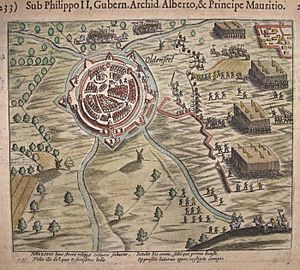Siege of Oldenzaal (1597) facts for kids
Quick facts for kids Siege of Oldenzaal (1597) |
|||||||
|---|---|---|---|---|---|---|---|
| Part of the Eighty Years' War and the Anglo–Spanish War | |||||||
 Siege of Oldenzaal in 1597 |
|||||||
|
|||||||
| Belligerents | |||||||
| Commanders and leaders | |||||||
| Strength | |||||||
| 4,000 infantry & cavalry | 400 | ||||||
| Casualties and losses | |||||||
| Low | All captured | ||||||
The Siege of Oldenzaal was a quick battle that happened between October 20 and 23, 1597. It was part of two bigger wars: the Eighty Years' War and the Anglo–Spanish War. A combined army from the Dutch Republic and England, led by Maurice of Orange, attacked the city of Oldenzaal.
The city quickly gave up to the much larger Dutch and English forces. This siege was part of a very successful military plan by Maurice of Orange in 1597. This period was later called the Ten Glory Years because of his many victories against the Spanish.
Contents
Why the Siege Happened
In 1597, Maurice of Orange started a major military campaign. He had already won many battles in the eastern part of the Netherlands. Earlier that year, his forces captured several cities. These included Rheinberg, Meurs, Grol, and Bredevoort.
The battles for Grol and Bredevoort were very tough. After taking Bredevoort, the city was even looted. Maurice then moved his army to Enschede. That city also gave up quickly.
Dividing the Army
After Enschede, Maurice decided to split his army. He wanted to capture two towns at the same time: Oldenzaal and Ootmarsum. Captain Van Duivenvoorde took part of the army, including English and Scottish soldiers. They went from Enschede to Ootmarsum, which also surrendered.
Meanwhile, Maurice and his cousin, William Louis, led their part of the army to Oldenzaal. This force had about 4,000 soldiers. The remaining English troops were with Horace Vere.
Oldenzaal's Situation
Oldenzaal had been controlled by the Spanish since 1572. The Catholic Church was very strong there. Every year, people in Oldenzaal celebrated kicking out the Beggars (a group who fought against Spanish rule).
The city's defenses included a main wall and six strong points called bastions. It also had a moat (a deep ditch filled with water) and an earthen rampart. However, some of these defenses were not fully finished.
The Battle and What Happened Next
About 400 soldiers defended Oldenzaal. Their leader was Governor Frederick Boymer. They had only one large cannon. This was not much against Maurice's large army. Maurice's Dutch and English troops set up camp north of Oldenzaal.
The siege began quickly. The city's defenders fired their cannon and matchlock guns. Some of the attackers even ran away from their unfinished defenses. They left their gabions (large baskets filled with earth for protection) empty.
Spanish Surrender
This small problem for the attackers did not last long. The Spanish soldiers inside Oldenzaal soon realized they were greatly outnumbered. They decided to talk about giving up. They wanted to surrender with honor.
Terms were agreed upon with the governor and the church leaders. The Spanish soldiers were allowed to leave for Lingen. They left with all their honors, meaning they could keep their weapons and flags. The next day, Maurice marched his winning troops into Oldenzaal.
After the Victory
After taking Oldenzaal and Ootmarsum, Maurice's forces joined back together. They then marched to Lingen and captured that city too. This ended a very successful year of fighting for Maurice.
Taking Oldenzaal and Lingen was a big success for Maurice. These victories helped make the eastern borders of the Dutch Republic stronger. This successful time was known as the Ten Glory Years.
Later, in 1605, Ambrogio Spinola captured Oldenzaal back for Spain. But in 1626, Frederick Henry took it back again. After that, Oldenzaal stayed permanently in Dutch hands.
More to Explore
- List of stadtholders in the Low Countries
- List of governors of the Spanish Netherlands
- Capture of Enschede (1597)
- Siege of Groenlo (1597)

